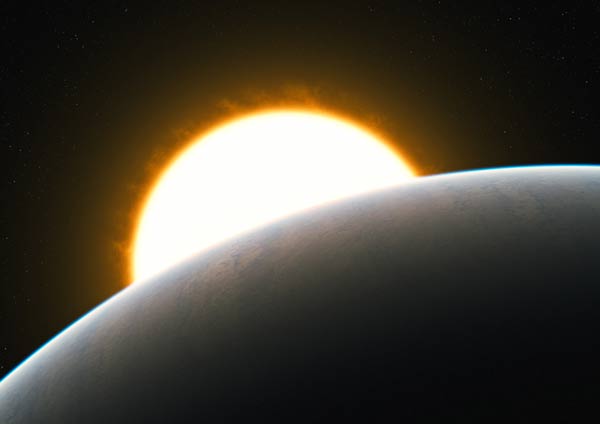
Researchers in the Netherlands and in the US are the first to measure directly the mass of a planet orbiting a star other than our Sun. In developing their new technique, they also discovered that this planet, which is approximately the same size as Jupiter but closer to its star, is being tormented by a raging storm.
Previous attempts to gauge the mass of such exoplanets have relied on estimations, where astrophysicists look at the slight “wobble” of a star caused by the gravitational pull of the planet. The extent of this movement can be used to estimate the planet’s mass as a proportion of the stellar mass – which itself is an estimate based on its spectral characteristics and distance from Earth.
Ignas Snellen of Leiden University led a team in developing a more accurate method by focusing on the atmosphere of an exoplanet. They demonstrate the technique on HD 209458b, a well known “hot Jupiter” some 150 light-years from Earth. Because this planet sweeps between Earth and its host star, every three and a half days, it changes the star’s chemical spectrograph as recorded on Earth. By comparing the star’s spectrograph before and during a transit the researchers can calculate the chemical content of the planetary atmosphere.
Doppler shift
Using the Very Large Telescope (VLT) in Chile, fitted with the CRIRES spectrograph, Snellen’s team was able to hone in on the planet’s carbon-monoxide (CO) signal, which was predicted to produce many spectral lines over these wavelengths. They were able to detect a small Doppler shift in the CO gas. From this they could calculate that the planet is orbiting its star at a velocity of 140 km s–1.
With relative ease, Snellen’s team was then able to calculate the masses of both star and planet using Newton’s law of gravitation, knowing also the velocity of the host star due to its orbit round the centre of mass of the system. “This is exactly the same method used to calculate the mass of binary star systems, except one of the bodies here is an exoplanet,” says Snellen.
Obtaining more accurate values for exoplanet masses could enable researchers to glean more information about the nature of exoplanets. “The mass is one of the most important parameters of the planet. It is by measuring the mass, together with other properties such as orbital period and eccentricity and radius, that we learn what exoplanets are made of, and how they form and evolve,” says Susan Aigrain, an exoplanet researcher at the University of Oxford in the UK.
A raging storm
The second result of this research is the discovery of an intense wind at high altitudes in the planet’s atmosphere. The researchers see that during the planet’s transit in front of the star, the whole CO signal is blue-shifted with respect to the velocity of the star, suggesting that the atmosphere is moving towards us. This observation fits with the prediction that hot gases from the planet’s day side flowing towards its cooler night side.
“Exoplanet atmospheres will be among the richest topics to explore over many years to come. Some examples of what we want to learn more about include cloud formation and weather in exoplanet atmospheres,” says Markus Janson, another exoplanet researcher at the University of Toronto.
The researchers intend to develop their research by building a more detailed profile of this exoplanet’s atmosphere. They have already secured a further 155 hours’ operational time on the VLT to be spread over the next two years.
Snellen hopes that in the longer term, his group’s technique could be used to investigate more Earth-like planets, which are significantly smaller and therefore more difficult to observe. “From looking at our own planet we can see that life has a very large influence on the composition of the atmosphere, especially with the presence of oxygen and ozone,” he says.
This research is published in this week’s Nature.



